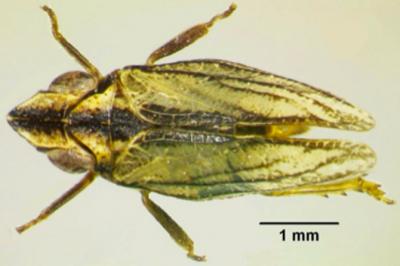New planthopper species found in southern Spain

This is a dorsal view of a Conosimus baenai female. Credit: Entomological Society of America
The new species, Conosimus baenai, has been named after Manuel Baena, a Spanish hemipterologist, for his contributions to the taxonomy of Iberian Hemiptera.
Conosimus baenai differs in appearance from the other species in the Conosimus genus due to the coloration of its forewings and veins. All of the other species have veins that are the same color as their wings, which are usually light brown or light-brown yellowish.
However, Conosimus baenai has light yellow or greenish-yellow wings with radial and median veins that are framed by dark brown or black stripes.
The new species was found in a medium-high mountain area that is dominated by thorny shrubs called Echinospartum boissieri, of which it seems to be associated.
This rare shrub, which is endemic to the Baetic Range in southern Spain, blooms and produces fruit from July to August.
The other five species in the genus are C. coelatus, C. malfanus, C. violantis, C. noualhieri, and C. horvathi.
The full open-access article is available at http://www.insectscience.org/14.92/.
The Journal of Insect Science is published by the Entomological Society of America, the largest organization in the world serving the professional and scientific needs of entomologists and people in related disciplines. Founded in 1889, ESA today has nearly 7,000 members affiliated with educational institutions, health agencies, private industry, and government. Members are researchers, teachers, extension service personnel, administrators, marketing representatives, research technicians, consultants, students, and hobbyists. For more information, visit http://www.entsoc.org.
Media Contact
All latest news from the category: Life Sciences and Chemistry
Articles and reports from the Life Sciences and chemistry area deal with applied and basic research into modern biology, chemistry and human medicine.
Valuable information can be found on a range of life sciences fields including bacteriology, biochemistry, bionics, bioinformatics, biophysics, biotechnology, genetics, geobotany, human biology, marine biology, microbiology, molecular biology, cellular biology, zoology, bioinorganic chemistry, microchemistry and environmental chemistry.
Newest articles

A universal framework for spatial biology
SpatialData is a freely accessible tool to unify and integrate data from different omics technologies accounting for spatial information, which can provide holistic insights into health and disease. Biological processes…

How complex biological processes arise
A $20 million grant from the U.S. National Science Foundation (NSF) will support the establishment and operation of the National Synthesis Center for Emergence in the Molecular and Cellular Sciences (NCEMS) at…

Airborne single-photon lidar system achieves high-resolution 3D imaging
Compact, low-power system opens doors for photon-efficient drone and satellite-based environmental monitoring and mapping. Researchers have developed a compact and lightweight single-photon airborne lidar system that can acquire high-resolution 3D…





















